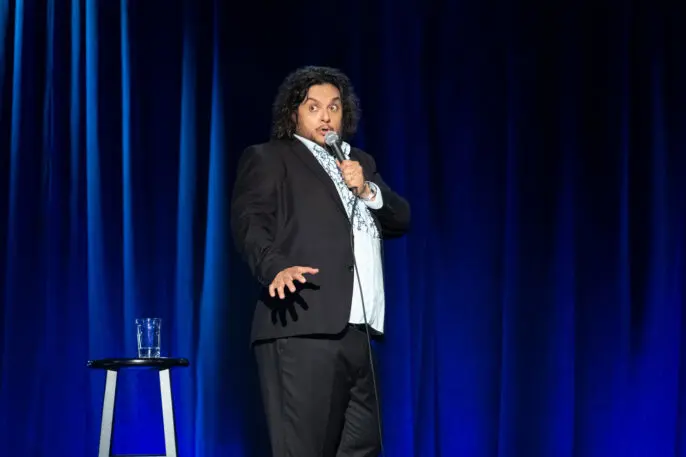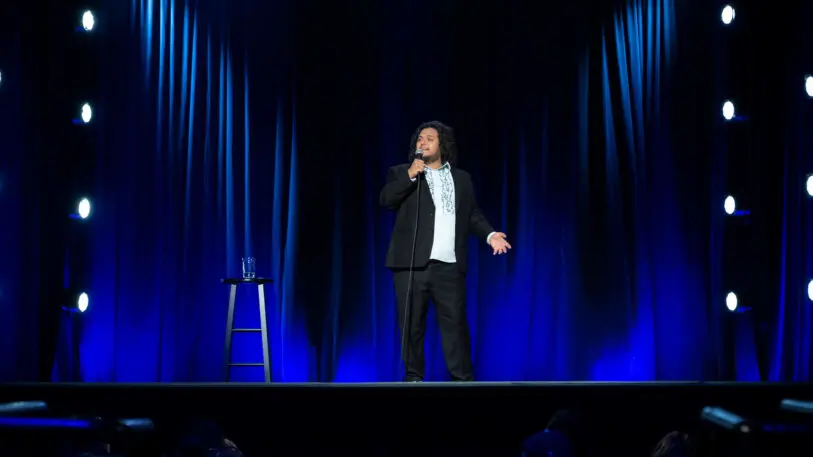Ever since Felipe Esparza put out his 2017 HBO special, Translate This, the Mexican-American comic has been trying to take his own advice.
With the new, two-part special, Bad Decisions/Malas Decisiones, out yesterday on Netflix, Esparza has finally succeeded, translating his laid-back snarky stand-up into Spanish.
To turn the idea into reality, though, he had to first learn how to properly speak the language.
“When Netflix asked me to do a special, I said ‘What if I do one in Spanish, too?'” the comic and What’s Up Fool? podcaster told Fast Company in a recent phone interview. “They said, ‘Can you speak Spanish?’ and I lied and said I could, even though I only spoke, like, slang Spanglish.”
Netflix consented to Esparza’s idea for a bilingual special, and then the comedian set out to learn how to perform comedy in a language he couldn’t speak anywhere near fluently.
The process was even harder than it sounds.
First, he had to check his pride at the door. Esparza was born in Mexico and raised in East Los Angeles, has been a working stand-up since the mid-’90s, and a successful headliner since he won Last Comic Standing in 2010. But he had never done more than 10 minutes of jokes in Spanish before, so he had to start at the bottom. In 2018, his wife and business partner Lesa O’Daniel started getting him booked in opening slots for Spanish-language comedians like Paty Bacelis, who was headlining at The Comedy Palace in San Diego.
Through performing in shows like this one, Esparza met a group of comedians from Tijuana, including Joel Sotomayor, who offered to transcribe Esparza’s Bad Decisions act from English to Spanish. Esparza then studied his transcription, and added tweaks to make it flow as well in Spanish as in English.
By the time he went to Tijuana himself for his initial stab at a full stand-up set in Spanish, Esparza had 45 minutes of material. He started crossing the border three times a month, gradually fine-tuning and expanding his set until it ballooned to over an hour.

“In the beginning, I was thinking in English and then translating my jokes in my mind in Spanish before saying them, which was taking forever, so I had to do pretty much what a method actor does,” Esparza says. “The way some actors want to get deep into a character to get ready for shooting, if I had to do a Spanish show one day, I would wake up and think in Spanish immediately. Then I’d listen to a Spanish radio station in the morning. And then I would listen to Fox Desportes and listen to Spanish music all day and Spanish podcasts. And once I got to San Diego or Tijuana, I would try to avoid people speaking in English, so that when I pull up on stage, everything was already embedded in me from Spanish.”
Some of the jokes from his act did not land with Spanish-language audiences. The scant few puns that peppered his jokes had no workable translation, and some of Esparza’s cultural references fell on deaf ears. The home of the Slurpee, 7-11, for instance, isn’t widely known throughout Mexico, and the Spanish translation, Siete-Once, meant nothing to the crowds at his shows. Esparza took to saying ‘mini marqueta’ instead, at the suggestion of one of his new Tijuana comedian friends, and the audience understood exactly what he meant.
After months of refining, Esparza knew he had his act down cold in two languages.
“I know my special is ready to perform when I can open up with my closer and end with my opening joke,” he says. “I don’t follow any order. I know that I have to do an hour, but I follow the waves. I’m up there surfing, like on a comedy surfboard. If I see a bad wave, I’m going to have to switch to a better one because I gotta keep the momentum going, and I’ll get back to the other joke later.”

Now that Esparza has under his belt the bilingual comedy special he’d been quietly considering for years, he’s already planning a potential follow-up to this format.
“I’m gonna do another dual-language comedy special in the future,” he says. “I already have 15 minutes of Spanish comedy that’s different from the special, but I really want to learn how to speak another language, like how Eddie Izzard did a special in French.”
“Maybe I could learn Italian or something,” he adds.
Perhaps Netflix will take his word again, if he claims to already be fluent in Italian.
Recognize your brand’s excellence by applying to this year’s Brands That Matter Awards before the early-rate deadline, May 3.
